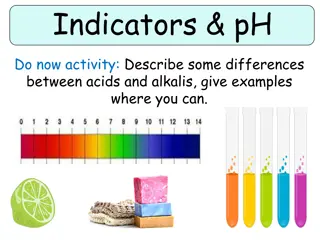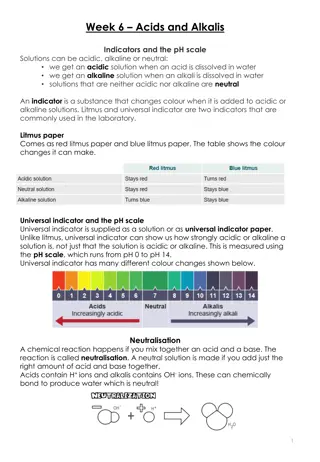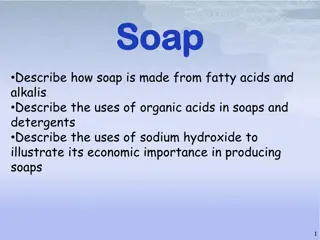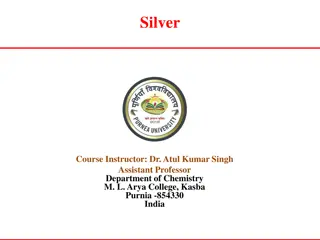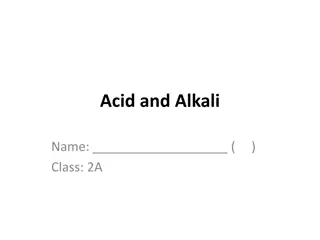Understanding Acids and Alkalis: pH Scale and Indicators
Explore the differences between acids and alkalis, learn about indicators, pH scale, and how to categorize solutions as acidic, alkaline, or neutral. Understand the importance of universal indicators in determining acid and alkali strength. Discover the disadvantages of using red and blue litmus pap
3 views • 11 slides
Understanding Acids, Alkalis, Indicators, and the pH Scale
Solutions can be acidic, alkaline, or neutral depending on whether an acid or alkali is dissolved in water. Indicators like litmus and universal indicator help determine acidity or alkalinity. The pH scale measures this, with 7 being neutral. Neutralization reactions occur when an acid and a base re
0 views • 5 slides
Understanding Porcelain and Feldspar in Ceramics
Brick clays high in alkalis and iron but low in alumina facilitate forming processes. Porcelain, made from Kaolin, quartz, and feldspar, is a vitreous ceramic fired at high temperatures. Different types of porcelain, including soft-paste and hard-paste, vary in clay and alumina content affecting fir
0 views • 4 slides
Understanding Chemical Hair Relaxers: Thio vs. Hydroxide
Chemical hair relaxers like Thio and Hydroxide are common methods for straightening extremely curly hair. Thio relaxers use Ammonium Thioglycolate to break disulfide bonds, while Hydroxide relaxers contain strong alkalis that swell hair fibers. The process involves lanthionization and neutralization
0 views • 37 slides
Understanding Soap Making and Uses of Sodium Hydroxide
Soap, an ancient detergent made from fatty acids and alkalis like sodium hydroxide, has been utilized for over 3000 years. Fats and oils are essential raw materials for soap production, and organic acids play a role in creating esters. Sodium hydroxide, a key component in soap making, showcases its
0 views • 9 slides
Chemical Properties and Uses of Silver: A Comprehensive Overview
Dr. Atul Kumar Singh, Assistant Professor at M.L. Arya College, provides detailed information on the chemical properties of silver, including its reactions with air, halogens, acids, alkali cyanides, alkalis, and sulphur. The text also highlights the various uses of silver in coinage, ornaments, and
0 views • 7 slides
Understanding Acid and Alkali Reactions
Explore the effects of acid rain on soil and ecosystems, learn about pH measurements in solutions, and witness the reactions of litmus paper with acids and alkalis. Follow the journey of an environmental consultant assisting a farmer facing plant growth issues on his farm.
0 views • 15 slides
Understanding Beta Pleated Sheet Structure in Proteins
Beta pleated sheet structure is a secondary structure found in proteins where peptide chains lie side by side to form a flat sheet held together by hydrogen bonds. Proteins like keratin and fibroin exhibit this structure, while denaturation can alter the secondary and tertiary structures of proteins
0 views • 9 slides
